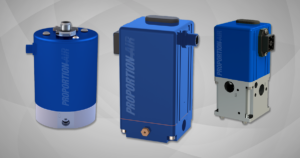Pneumatics: Power and Safety Behind Modern Thrill Rides
The Kingda Ka roller coaster at Six Flags Great Adventure & Safari in Jackson, New Jersey, propels riders up a 456-foot-high hill, reaching 128 mph in 3.5 seconds. Built in 2005, it was the tallest and fastest steel coaster in the world until 2010, when Ferrari World Abu Dhabi debuted its Formula Rossa coaster, setting a new speed record of 149.1 mph.
These modern thrill rides are a far cry from the first roller coaster in the United States, which reached a top speed of about 6 mph when it debuted in 1884. All roller coasters, regardless of when they were built, rely on the same basic principles of physics: kinetic energy, centripetal force, friction and resistance. But today, coasters use pneumatics and hydraulics to create a more thrilling and safer experience for passengers.
Take a look at pneumatics at work behind some of the biggest and best known coasters:
Do-Dodonpa
The Do-Dodonpa coaster at Fuji-Q Highland Amusement Park in Japan is the only coaster in the world that uses a compressed air launch system. Using patented technology, the air shoots the coaster down a narrow tube to begin the ride. The train reaches a speed of 112 mph in less than two seconds. It’s currently tied for fourth fastest roller coaster in the world with the Red Force, a coaster in Spain.
Intimidator 305
On the Intimidator 305 at King’s Dominion in Virginia, air is used to control the brake run, which is the part of a track that stops a roller coaster. Actuator-mounted magnetic plates turn the brake run on and off. The Kingda Ka also uses this technology on its magnetic brake system. Magnetic brakes are safer than brakes that use friction because they do not touch the train, so they are not affected by elements like rain.
Splash Mountain
While high speeds aren’t the goal of Disney’s Splash Mountain rides, a pneumatic solution was required to slow the ride down safely yet keep the train moving through watery terrain. The more than 50-foot drop is slowed by a two 40-foot pneumatic brakes. Eight airbags actuate each brake pad. A valve is located in the middle of each airbag. As pressurized air fills the bags, they expand and touch the underside of the train, slowing it.
Coaster enthusiasts seem to expect more innovation every year – inversions, negative G-forces, dizzying spirals, wing-style trains that flip riders in four dimensions – and engineers continue coming up with ways to answer those demands. Check out plans for the Skyscraper, a roller coaster scheduled to open in 2020 at Skyplex in Orlando. The Skyscraper will be the tallest coaster in the world at more than 500 feet and feature the steepest drop (123 degrees) and highest inversion (near the top).
Happy riding!

 April Newsletter: Pneumatic Education
April Newsletter: Pneumatic Education  We’ve got the blues – and it’s a good thing
We’ve got the blues – and it’s a good thing